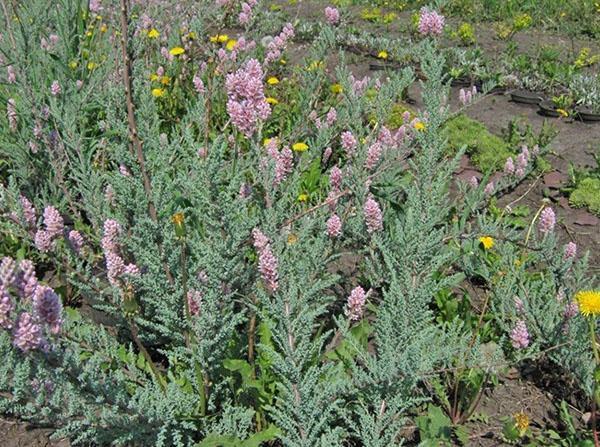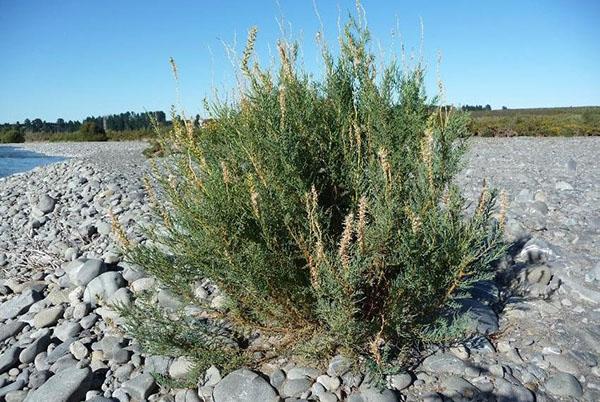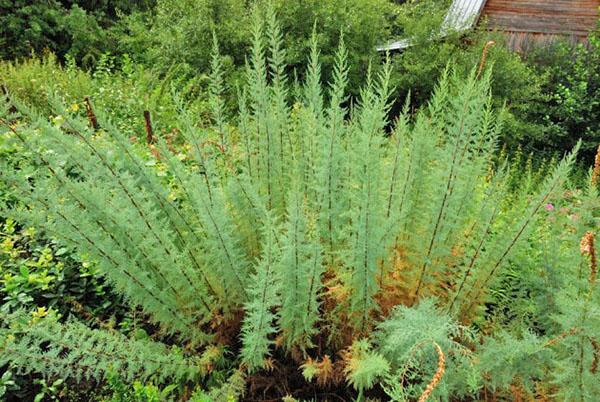Fox-tailed Mirikaria - an unusual garden decoration
 Fox-tailed Mirikaria is an original rare plant with few varieties. The spreading deciduous shrub myrikaria has a bizarre crown with a silvery sheen and bright elongated inflorescences. Despite its unpretentiousness, this plant is not widely spread.
Fox-tailed Mirikaria is an original rare plant with few varieties. The spreading deciduous shrub myrikaria has a bizarre crown with a silvery sheen and bright elongated inflorescences. Despite its unpretentiousness, this plant is not widely spread.
Description of the plant

A feature of the plant is its rapid growth. Myrikaria can be up to two meters high and up to one and a half meters wide. Forms a bush of up to two dozen shoots that grow directly from the root. The leaves of the shrub are small, densely arranged. They have smoky-gray shades that stand out from the rest of the greenery.
The myrikaria shrub produces beautiful panicle-shaped inflorescences that bloom gradually. The flowering period begins in May and lasts all summer. It is because of the drooping panicles of inflorescences that resemble a fox's tail that the plant got its name "fox-tailed". With the maturation of the seeds, the decorative qualities of the inflorescences only increase.
Planting and leaving
 Mirikaria does not make high demands on soil conditions and composition. If there is a choice, then the plant is planted in an open, well-lit place with no drafts and with moist loam. Planting is carried out either in early spring or late autumn.
Mirikaria does not make high demands on soil conditions and composition. If there is a choice, then the plant is planted in an open, well-lit place with no drafts and with moist loam. Planting is carried out either in early spring or late autumn.
When grown in partial shade or shade, the duration and abundance of flowering is significantly reduced.
Planting a seedling
 A planting pit with good drainage is prepared for the seedling. For a better result, mineral and organic fertilizers... After placing the seedling in the prepared hole, sprinkle it with earth and tamp the soil. It is recommended to mulch the trunk circle immediately.
A planting pit with good drainage is prepared for the seedling. For a better result, mineral and organic fertilizers... After placing the seedling in the prepared hole, sprinkle it with earth and tamp the soil. It is recommended to mulch the trunk circle immediately.
It is advisable to transplant to a new place only young plants that are less than two years old. This is done by transshipment with a large clod of earth to preserve the roots.
Since the shrub will eventually have a spreading crown, there should be a distance of at least a meter to one and a half between separately located plants.
Organization of watering
 Since the shrub belongs to moisture-loving plants, planting and caring for myrikaria should provide for a good watering... An adult plant can tolerate both periods of temporary drought and excess moisture.
Since the shrub belongs to moisture-loving plants, planting and caring for myrikaria should provide for a good watering... An adult plant can tolerate both periods of temporary drought and excess moisture.
In the absence of precipitation, it is necessary to pour 10 liters of water under the bush weekly. With good moisture, the perennial bush will bloom profusely and grow well.
Fertilization
 After planting and after planting, care for the shrub myrikaria foxtail needs one that includes feeding. It is recommended to apply it during the period of growth and flowering of the plant: from spring to summer.
After planting and after planting, care for the shrub myrikaria foxtail needs one that includes feeding. It is recommended to apply it during the period of growth and flowering of the plant: from spring to summer.
Cropping: to do or not to do
 If myrikaria is grown for the purpose of decorating and improving the site, periodic pruning can be organized. In this case, the shrub will acquire a well-groomed appearance and obtain a compact form. Pruning can be done in spring and summer. If you do not follow the shape, the branches grow chaotically.
If myrikaria is grown for the purpose of decorating and improving the site, periodic pruning can be organized. In this case, the shrub will acquire a well-groomed appearance and obtain a compact form. Pruning can be done in spring and summer. If you do not follow the shape, the branches grow chaotically.
Annual cutting of the bush will allow you to give it an attractive shape, for example, a hemisphere.
When winter is near
 Mirikaria tolerates even severe frosts down to -40 ° C. In this regard, the plant does not require special covering. But to facilitate wintering, it is recommended to prepare the bush.
Mirikaria tolerates even severe frosts down to -40 ° C. In this regard, the plant does not require special covering. But to facilitate wintering, it is recommended to prepare the bush.
To do this, perform the following work:
- Tie compactly the shoots of the shrub.
- Bend the connected branches to the ground.
These actions will help prevent frostbite on the branches and make it easier for the plant to transition from winter to spring. At the same time, plant recovery is much easier even in cases where shoots are damaged by heavy wet snow or severe frosts.
Fox-tailed myrikaria: breeding features

Planting and caring for myrikaria is not difficult. An unpretentious shrub can be propagated in several ways:
- seeds;
- cuttings;
- branch overgrown.
Seed breeding method
 This method of breeding myrikaria is less popular than cuttings. Florists consider it ineffective and overly laborious. Even the storage of seeds is difficult, since they require sealed packaging and a moderate temperature regime.
This method of breeding myrikaria is less popular than cuttings. Florists consider it ineffective and overly laborious. Even the storage of seeds is difficult, since they require sealed packaging and a moderate temperature regime.
If the rules for storing seeds are not followed, they may lose germination.
To increase germination, the seed should be hardened for 5 days at a low temperature - about + 4 ° C. For seeds that have not undergone such hardening, the germination rate is no more than a third of the seed.
Planting seeds:
- Preparing a container for germinating seeds.
- Filling in the potting mix.
- Sowing seeds (without covering with soil on top).
- Organization of drip irrigation.
If properly organized, the seeds will germinate in a few days. After the sprouts have grown, they can be transplanted into open ground.
Planting seeds in open ground should only be carried out in warm weather.
Propagation by cuttings
 Breeding myrikaria with foxtail cuttings is an effective way of breeding a dwarf shrub. It is carried out in the spring, before the buds begin to bloom.
Breeding myrikaria with foxtail cuttings is an effective way of breeding a dwarf shrub. It is carried out in the spring, before the buds begin to bloom.
Work order:
- Cut the cuttings 15 to 25 cm long.
- Prepare a potting mix consisting of sand, peat, humus and soil. All components are taken in equal amounts.
- Cuttings are planted at an angle, leaving 3 buds above the surface.
For better rooting of cuttings, it is recommended to use a root formation stimulator before planting.
Rooted cuttings form new plants. For a climate in which frosts are present in winter, it is possible to leave new plants in the ground only in the second year in order to avoid freezing out of the immature young myrikaria.
The first flowering after cuttings occurs after two years. The plant reaches full growth only 4-5 years after planting the cuttings. Since the plant is perennial, it does not need additional replanting.
 Mirikaria is a spectacular plant suitable for landscaping. It organically fits into plant compositions, benefiting from the peculiarities of its colors. The fox-tailed myrikaria beautifully complements alpine slides, rockeries and artificial reservoirs.
Mirikaria is a spectacular plant suitable for landscaping. It organically fits into plant compositions, benefiting from the peculiarities of its colors. The fox-tailed myrikaria beautifully complements alpine slides, rockeries and artificial reservoirs.